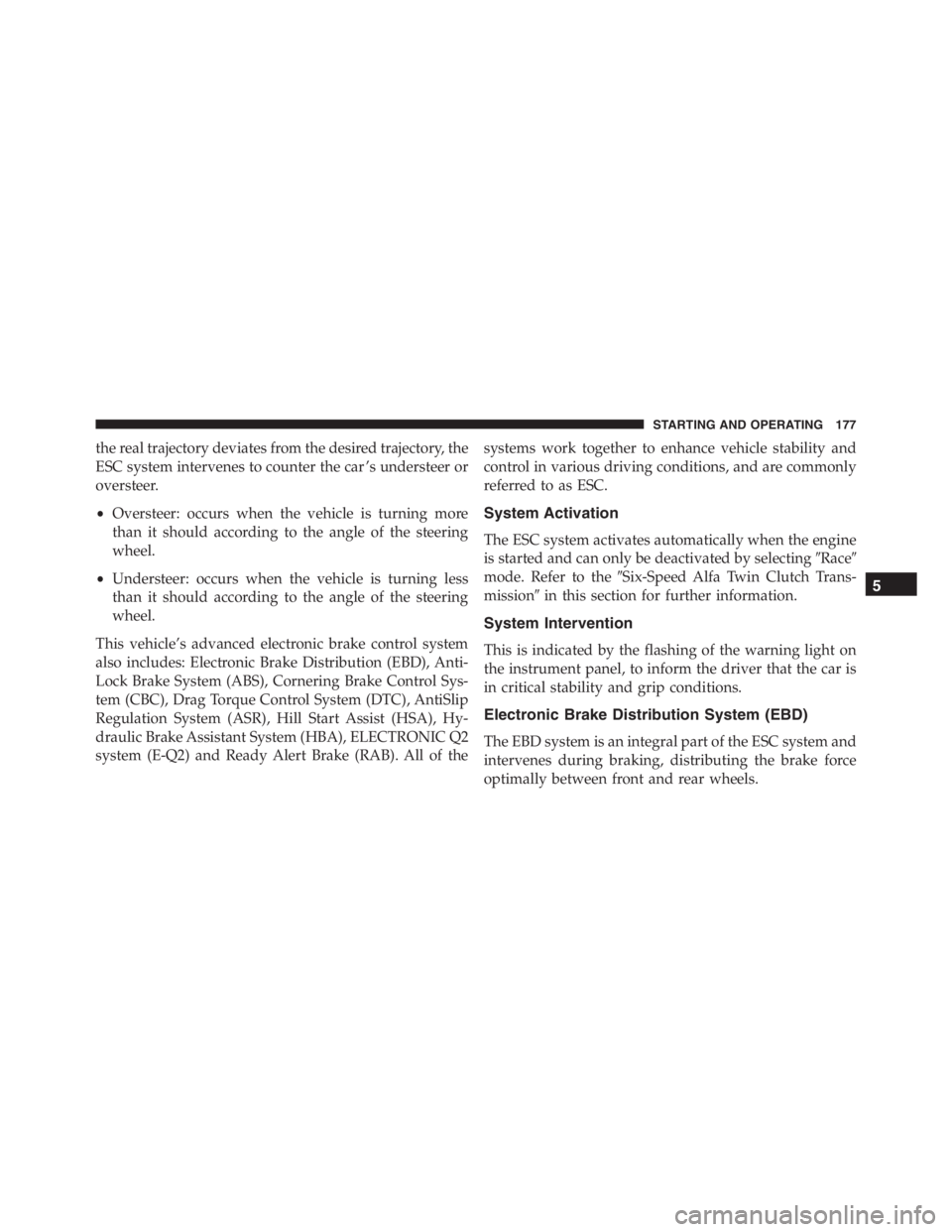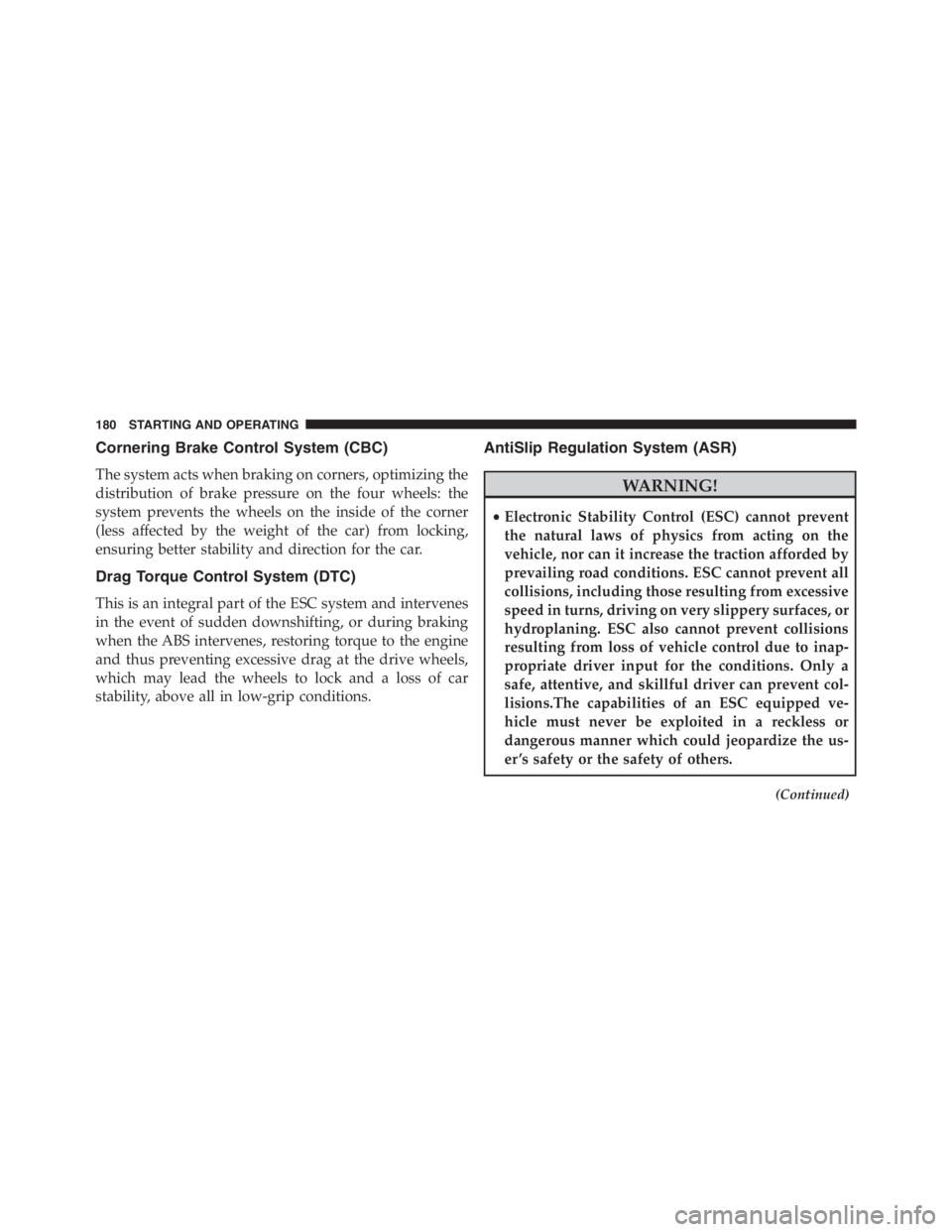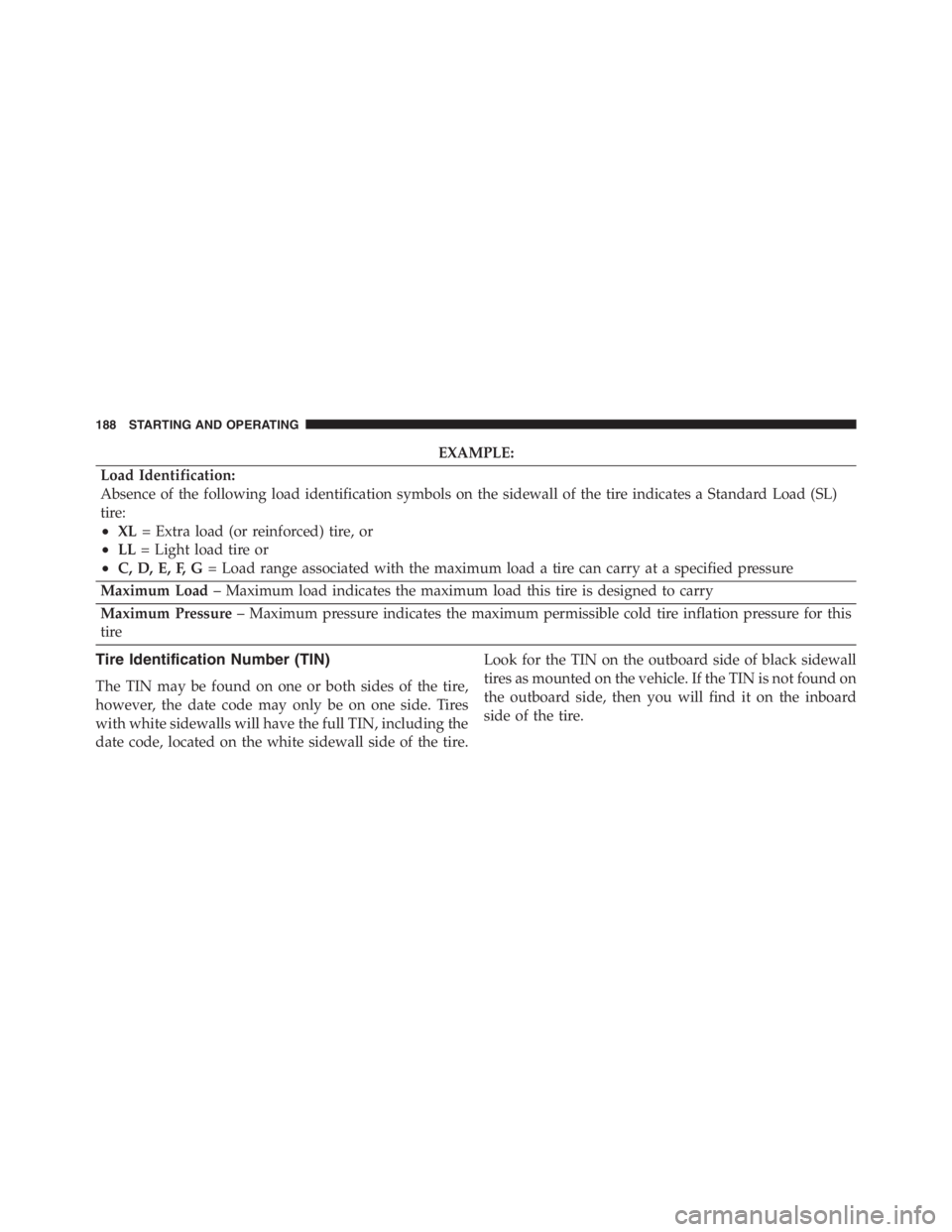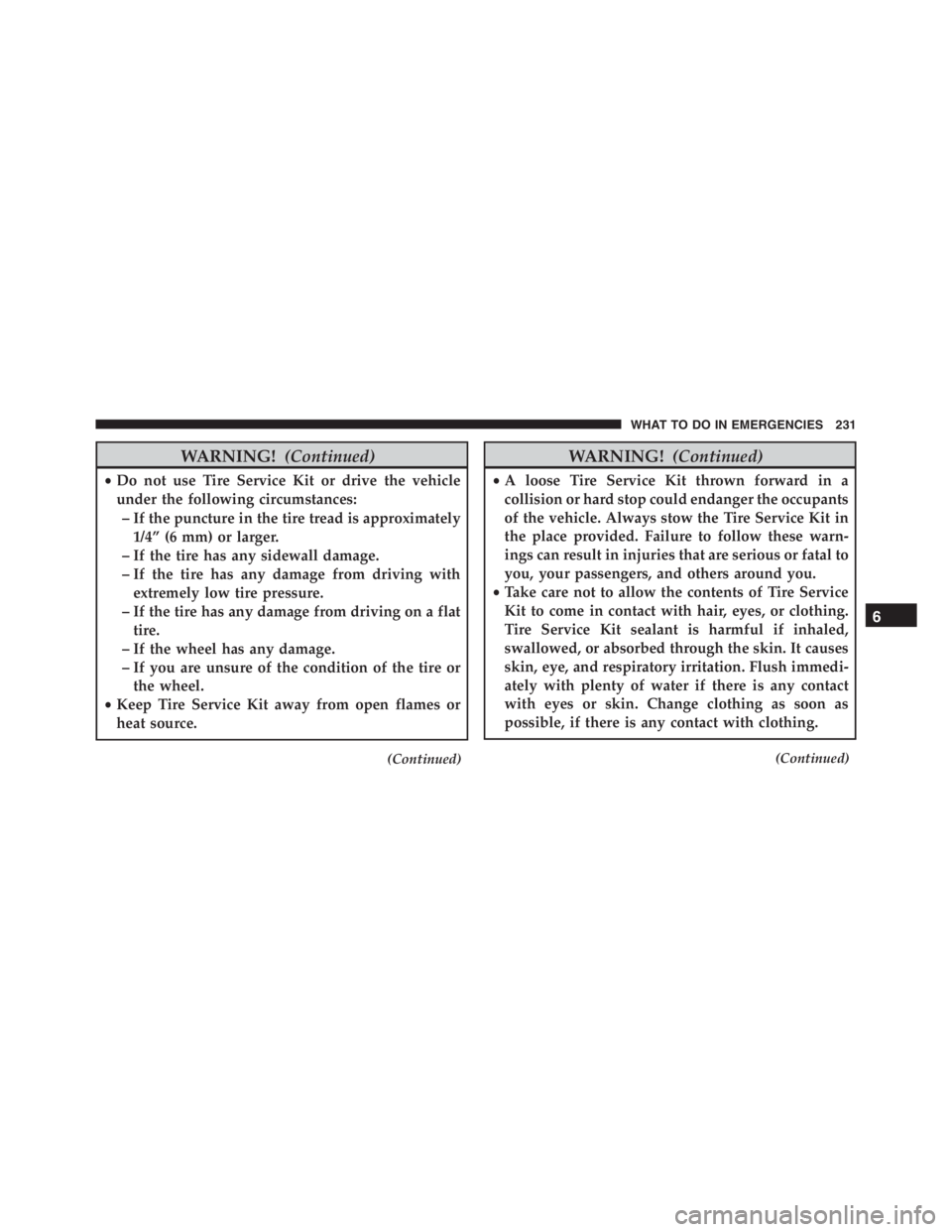Page 179 of 348

the real trajectory deviates from the desired trajectory, the
ESC system intervenes to counter the car ’s understeer or
oversteer.
•Oversteer: occurs when the vehicle is turning more
than it should according to the angle of the steering
wheel.
•Understeer: occurs when the vehicle is turning less
than it should according to the angle of the steering
wheel.
This vehicle’s advanced electronic brake control system
also includes: Electronic Brake Distribution (EBD), Anti-
Lock Brake System (ABS), Cornering Brake Control Sys-
tem (CBC), Drag Torque Control System (DTC), AntiSlip
Regulation System (ASR), Hill Start Assist (HSA), Hy-
draulic Brake Assistant System (HBA), ELECTRONIC Q2
system (E-Q2) and Ready Alert Brake (RAB). All of thesystems work together to enhance vehicle stability and
control in various driving conditions, and are commonly
referred to as ESC.
System Activation
The ESC system activates automatically when the engine
is started and can only be deactivated by selecting�Race�
mode. Refer to the�Six-Speed Alfa Twin Clutch Trans-
mission�in this section for further information.
System Intervention
This is indicated by the flashing of the warning light on
the instrument panel, to inform the driver that the car is
in critical stability and grip conditions.
Electronic Brake Distribution System (EBD)
The EBD system is an integral part of the ESC system and
intervenes during braking, distributing the brake force
optimally between front and rear wheels.
5
STARTING AND OPERATING 177
Page 180 of 348

This guarantees greater braking stability for the vehicle,
preventing sudden locking of the rear wheels and the
consequent instability of the vehicle.
Four-Wheel Anti-Lock Brake System (ABS)
The Four-Wheel ABS is designed to aid the driver in
maintaining vehicle control under adverse braking con-
ditions. The system operates with a separate computer to
modulate hydraulic pressure, to prevent wheel lock-up
and to help avoid skidding on slippery surfaces.
The system’s pump motor runs during an ABS stop to
provide regulated hydraulic pressure. The pump motor
makes a low humming noise during operation, which is
normal.
The ABS includes an amber ABS Warning Light. When
the light is illuminated, the ABS is not functioning. The
system reverts to standard non-anti-lock brakes. Turningthe ignition Off and On again may reset the ABS if the
fault detected was only momentary.
WARNING!
•When the ABS intervenes and you feel the brake
pedal pulsating, do not reduce the pressure, but
hold it down firmly and confidently; in doing so
you will brake in the shortest distance possible,
depending on the current road conditions.
•For maximum efficiency of the braking system, a
bedding-in period of about 311 miles (500 km) is
required: during this period it is advisable to avoid
sharp, repeated and prolonged braking.
•If the ABS intervenes, this indicates that the grip of
the tires on the road is nearing its limit: you must
slow down to a speed compatible with the avail-
able grip.
(Continued)
178 STARTING AND OPERATING
Page 181 of 348

WARNING!(Continued)
•The ABS can’t overrule the natural laws of physics,
and can’t increase the grip available according to
the condition of the road.
•The ABS cannot prevent accidents, including those
due to excessive speed on corners, driving on
low-grip surfaces or aquaplaning.
•The capability of the ABS must never be tested
irresponsibly and dangerously, in such a way as to
compromise personal safety and the safety of oth-
ers.
•For the correct operation of the ABS, the tires must
of necessity be the same make and type on all
wheels, in perfect condition and, above all, of the
prescribed type and dimensions.When you are in a severe braking condition involving the
use of the ABS, you will experience some pedal drop as
the vehicle comes to a stop. This is the result of the
system reverting to the base brake system.
Engagement of the ABS may be accompanied by a
pulsing sensation. You may also hear a clicking noise.
These occurrences are normal and indicate that the
system is functioning properly.
System Intervention
A slight pulsing of the brake pedal and noise indicates
the intervention of the ABS: this is completely normal
when the system intervenes.
5
STARTING AND OPERATING 179
Page 182 of 348

Cornering Brake Control System (CBC)
The system acts when braking on corners, optimizing the
distribution of brake pressure on the four wheels: the
system prevents the wheels on the inside of the corner
(less affected by the weight of the car) from locking,
ensuring better stability and direction for the car.
Drag Torque Control System (DTC)
This is an integral part of the ESC system and intervenes
in the event of sudden downshifting, or during braking
when the ABS intervenes, restoring torque to the engine
and thus preventing excessive drag at the drive wheels,
which may lead the wheels to lock and a loss of car
stability, above all in low-grip conditions.
AntiSlip Regulation System (ASR)
WARNING!
•Electronic Stability Control (ESC) cannot prevent
the natural laws of physics from acting on the
vehicle, nor can it increase the traction afforded by
prevailing road conditions. ESC cannot prevent all
collisions, including those resulting from excessive
speed in turns, driving on very slippery surfaces, or
hydroplaning. ESC also cannot prevent collisions
resulting from loss of vehicle control due to inap-
propriate driver input for the conditions. Only a
safe, attentive, and skillful driver can prevent col-
lisions.The capabilities of an ESC equipped ve-
hicle must never be exploited in a reckless or
dangerous manner which could jeopardize the us-
er ’s safety or the safety of others.
(Continued)
180 STARTING AND OPERATING
Page 185 of 348

Hydraulic Brake Assistant System (HBA)
WARNING!
•The HBA system can’t overrule the natural laws of
physics, and can’t increase the grip available ac-
cording to the condition of the road.
•The HBA system cannot prevent accidents, includ-
ing those due to excessive speed on corners, driv-
ing on low-grip surfaces or aquaplaning.
•The capability of the HBA system must never be
tested irresponsibly and dangerously, in such a
way as to compromise the safety of the driver, the
other occupants of the car or any other road user.
The HBA system is designed to improve the car ’s braking
capacity during emergency braking. The system detects
emergency braking by monitoring the speed and force
with which the brake pedal is pressed, and consequentlyapplies the optimal brake pressure. This can reduce the
braking distance, the HBA system therefore completes
the ABS.
Maximum assistance from the HBA system is obtained
pressing the brake pedal very quickly. In addition, the
brake pedal should be pressed continuously during
braking, avoiding intermittent presses, to get the most
out of the system.
Do not reduce pressure on the brake pedal until braking
is no longer necessary.
The HBA system is deactivated when the brake pedal is
released.
5
STARTING AND OPERATING 183
Page 187 of 348

NOTE:
•P (Passenger) — Metric tire sizing is based on U.S.
design standards. P-Metric tires have the letter “P”
molded into the sidewall preceding the size designa-
tion. Example: P215/65R15 95H.
•European — Metric tire sizing is based on European
design standards. Tires designed to this standard have
the tire size molded into the sidewall beginning with
the section width. The letter�P�is absent from this tire
size designation. Example: 215/65R15 96H.
•LT (Light Truck) — Metric tire sizing is based on U.S.
design standards. The size designation for LT-Metric
tires is the same as for P-Metric tires except for the
letters “LT” that are molded into the sidewall preced-
ing the size designation. Example: LT235/85R16.•Temporary spare tires are designed for temporary
emergency use only. Temporary high pressure com-
pact spare tires have the letter “T” or “S” molded into
the sidewall preceding the size designation. Example:
T145/80D18 103M.
•High flotation tire sizing is based on U.S. design
standards and it begins with the tire diameter molded
into the sidewall. Example: 31x10.5 R15 LT.
5
STARTING AND OPERATING 185
Page 190 of 348

EXAMPLE:
Load Identification:
Absence of the following load identification symbols on the sidewall of the tire indicates a Standard Load (SL)
tire:
•XL= Extra load (or reinforced) tire, or
•LL= Light load tire or
•C, D, E, F, G= Load range associated with the maximum load a tire can carry at a specified pressure
Maximum Load– Maximum load indicates the maximum load this tire is designed to carry
Maximum Pressure– Maximum pressure indicates the maximum permissible cold tire inflation pressure for this
tire
Tire Identification Number (TIN)
The TIN may be found on one or both sides of the tire,
however, the date code may only be on one side. Tires
with white sidewalls will have the full TIN, including the
date code, located on the white sidewall side of the tire.Look for the TIN on the outboard side of black sidewall
tires as mounted on the vehicle. If the TIN is not found on
the outboard side, then you will find it on the inboard
side of the tire.
188 STARTING AND OPERATING
Page 233 of 348

WARNING!(Continued)
•Do not use Tire Service Kit or drive the vehicle
under the following circumstances:
– If the puncture in the tire tread is approximately
1/4” (6 mm) or larger.
– If the tire has any sidewall damage.
– If the tire has any damage from driving with
extremely low tire pressure.
– If the tire has any damage from driving on a flat
tire.
– If the wheel has any damage.
– If you are unsure of the condition of the tire or
the wheel.
•Keep Tire Service Kit away from open flames or
heat source.
(Continued)
WARNING!(Continued)
•A loose Tire Service Kit thrown forward in a
collision or hard stop could endanger the occupants
of the vehicle. Always stow the Tire Service Kit in
the place provided. Failure to follow these warn-
ings can result in injuries that are serious or fatal to
you, your passengers, and others around you.
•Take care not to allow the contents of Tire Service
Kit to come in contact with hair, eyes, or clothing.
Tire Service Kit sealant is harmful if inhaled,
swallowed, or absorbed through the skin. It causes
skin, eye, and respiratory irritation. Flush immedi-
ately with plenty of water if there is any contact
with eyes or skin. Change clothing as soon as
possible, if there is any contact with clothing.
(Continued)
6
WHAT TO DO IN EMERGENCIES 231